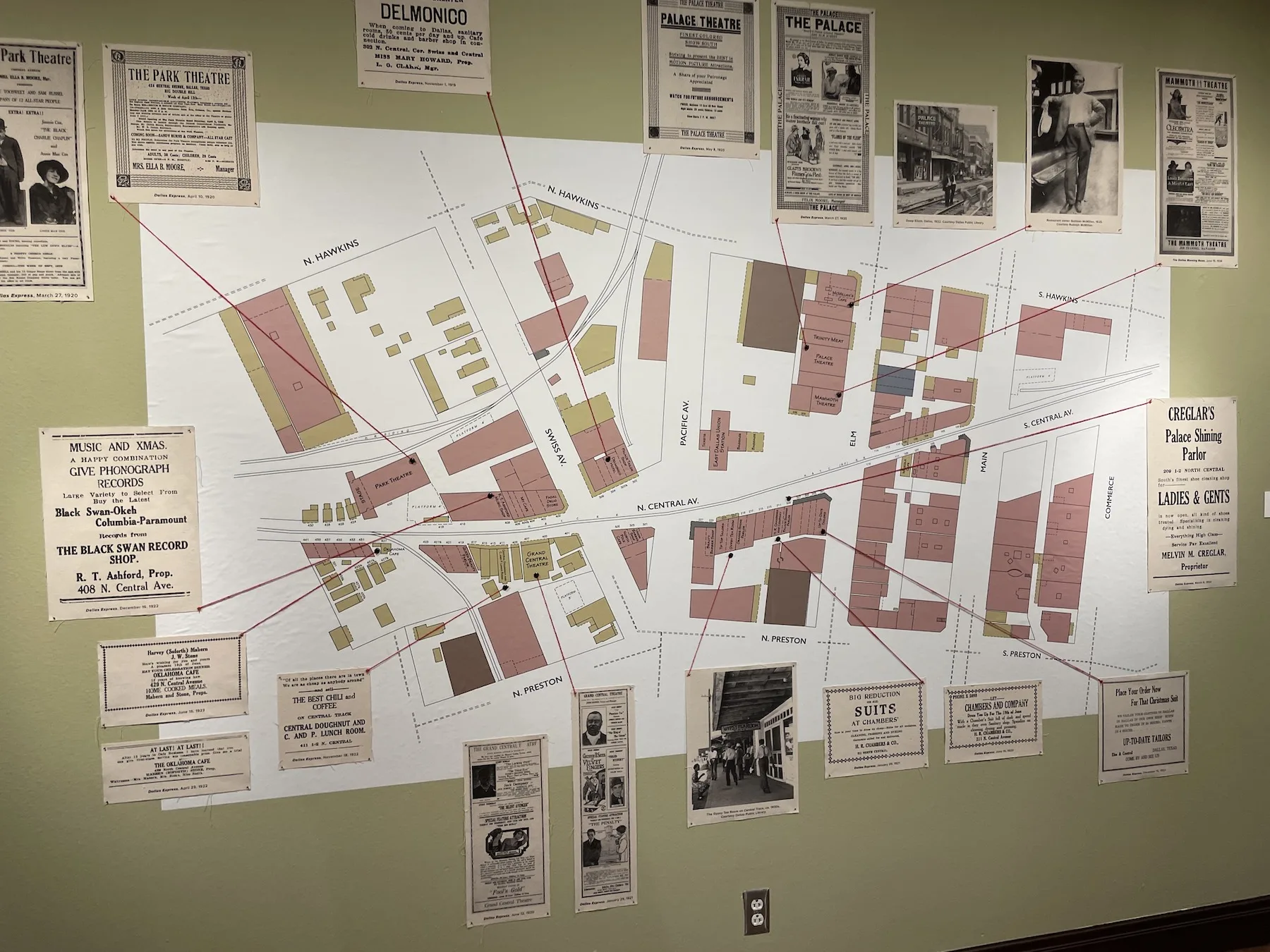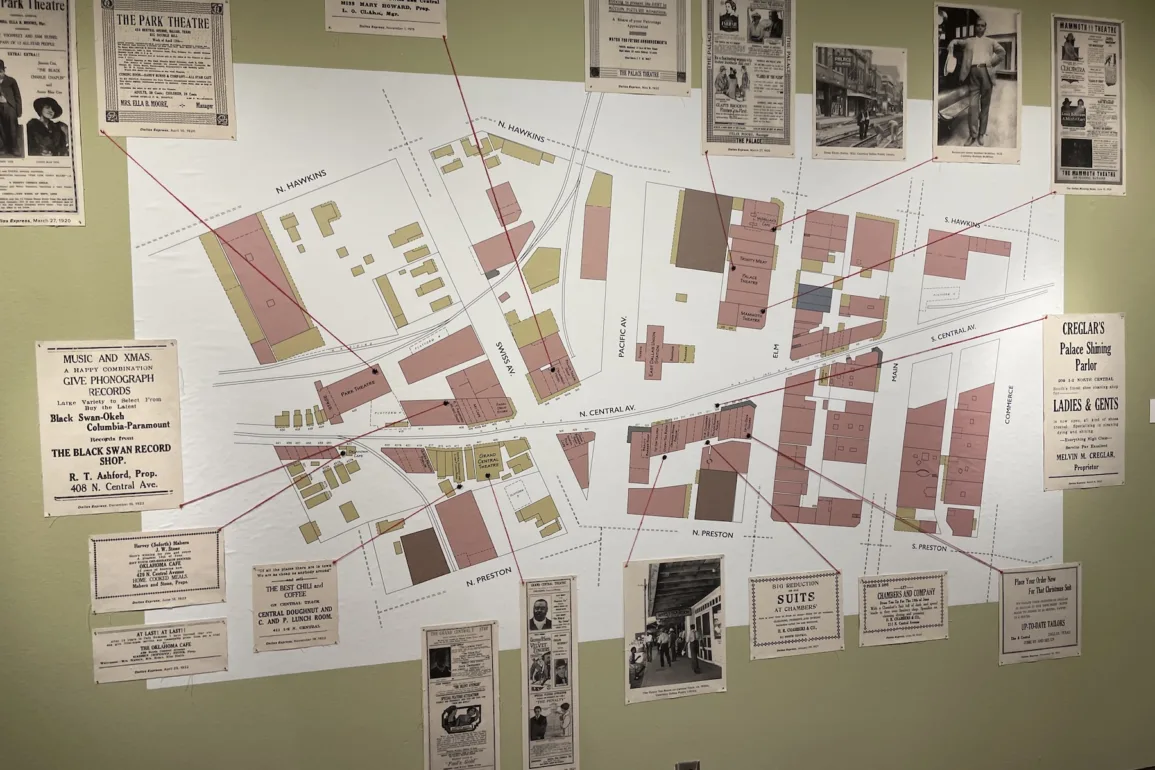
The exhibit Facing the Rising Sun: Freedman’s Cemetery opened in 2000 at the African American Museum in Fair Park, chronicling the history of the thriving Black community just north of present-day downtown. Curators Phillip Collins and Alan Govenar expected it to be up for only a year.
Two decades later, it’s still on display. It serves as the inspiration for two new exhibits in adjoining exhibition halls, Central Track: Crossroads of Deep Ellum and Seeing a World Blind Lemon Never Saw, which opened last week and commemorates the 150th anniversary of the historic neighborhood. Both, again, are organized by Collins, a curatorial advisor and former museum staffer, and Govenar, founder of Dallas-based Documentary Arts and a longtime chronicler of Deep Ellum.
“They’re an outgrowth of that exhibition,” Govenar said, exploring the same themes of trauma, racism, violence, resiliency, and geography as the original show. He also curated three accompanying pieces: When You Go Down in Deep Ellum and Unlikely Blues: Louis Paeth and Blind Lemon Jefferson at the new Deep Ellum Community Center; and Invisible Deep Ellum, an installation under the I-345 overpass that memorializes the Black-owned businesses that were destroyed when the highway was built.
The freeway replaced what was known as Central Track, the main corridor of the roughly seven block neighborhood between Elm Street and Swiss Avenue. Govenar described it as full of life as well as diversity. It’s a place where Jewish, Italian, Greek, and other European immigrants joined freed slaves who “came together if not by choice then necessity.” For a city whose power structure often claimed membership in the Ku Klux Klan, it was a safe space away (for a while) from strife.
The show highlights the reprehensible depiction of Black life in the 1920s by the Dallas Morning News, juxtaposing racist news clips with posters for minstrel shows from the same era. They’re all offensive, Govenar said, and that’s the point. But the subject matter is also the result of the limited depictions of Black life in the area.
Even as his book Deep Ellum: The Other Side of Dallas, co-written with longtime journalist Jay F. Brakefield, has just been published in its third edition by local publishing house Deep Vellum, no additional photographs have emerged from collectors or archives.
“It’s astounding,” he said.
The show tells the story of the neighborhood through press clippings from the News and other newspapers. One clip is about White socialites dining out because their servants were celebrating Juneteenth.
“The articles with this racist content could be a thesis,” he said.
They also redrew a map that identifies key structures in the neighborhood, culled from public records and newspapers. The map, articles, and clippings are printed on canvas as opposed to cardstock, representing the cotton Black enslaved people picked before Emancipation.
In the center of the exhibit is a large abstract sculpture, created with a large wooden rectangular cross slanted upward from the floor alongside a noose. Collins, who helped build the museum’s large and well-known folk art collection, said it represents the “fall of Central Track.”
The cross is a metaphor for its unintentional decline when North Central Expressway and I-345 ripped it apart in the 1940s.
Small shapes lining the wood represent houses and other structures that were lost, resulting in community displacement. The noose, he added, is also a reminder of the lynching of Black people in Dallas.
Across the hall in another exhibition space, “Seeing a World Blind Lemon Never Saw” is a conceptual show that documents the blues singer’s journey from southeast Texas to his eventual residence in Dallas. It complements a book of the same name, also published recently by Deep Vellum.
For three decades, Govenar has photographed Lemon’s journey and documented what has and hasn’t changed on the land he once traveled. The large print photographs track the landscape from Wortham, in East Texas, to Dallas. It represents the world Blind Lemon would have loved to see, Collins said.
The show is part of Govenar’s 36-year study of Lemon’s life, including a loose timeline from when he was first buried in an unmarked grave to decades later when the cemetery was named for him. He shares the history of a nearby church that was set on fire and rebuilt by the assailants after they were caught. There are older and newer homes in these photographs, and eccentric religious signs— “HIGHWAY TO HEAVEN”—mounted on a trailer with an Israeli flag dangling next to it. (Govenar believes it was created by Messianic Jews.) All are illuminated with precise lighting and each carry their own narrative. Those stories can veer away from the life Blind Lemon led, but still represent how the land has changed over time.
Collins said what links the three shows is the idea of violation. “Central Track was violated by the highway. These rural areas were violated by oil and gas pipes. And the cemetery made way for developers.”
As Deep Ellum celebrates its 150th year, the new exhibits seek to place its history at the center of the discussion.


